Survival horror is a subgenre of horror games. Although combat can be part of the gameplay, the player is made to feel less in control than in typical action games through limited ammunition or weapons, health, speed, and vision, or through various obstructions of the player's interaction with the game mechanics. The player is also challenged to find items that unlock the path to new areas and solve puzzles to proceed in the game. Games make use of strong horror themes, such as dark mazelike environments and unexpected attacks from enemies.

The Master is a fictional character on the action-horror/fantasy television series Buffy the Vampire Slayer (1997–2003). He is a centuries-old vampire portrayed by Mark Metcalf, determined to open the portal to hell below Sunnydale High School in the fictional town of Sunnydale where the main character Buffy Summers lives. The premise of the series is that Buffy is a Slayer, a teenage girl endowed with superhuman strength and other powers, which she uses to kill vampires and other evil beings. Each season of the series Buffy and the small group of family and friends who work with her, nicknamed the Scooby Gang, must defeat an evil force referred to as the Big Bad; the villain is usually trying to bring on an apocalypse. The Master is the first season's Big Bad.

Angel is a fictional character created by Joss Whedon and David Greenwalt for the American television programs Buffy the Vampire Slayer and its spin-off series Angel. The character is portrayed by actor David Boreanaz. As introduced in Buffy in 1997, Angel is a love interest for heroine Buffy Summers, a young woman whose destiny as "the Slayer" is to fight the forces of evil, such as vampires and demons. However, their relationship is complicated by the fact that Angel is himself a vampire cursed with remorse and a human soul, which motivates him to assist Buffy in her duties as Slayer. The character's popularity led to the production of the spin-off Angel, which follows the character's struggle towards redemption after moving to Los Angeles. In addition to the two television series, the character appears in the comic book continuations of both series, as well as much other expanded universe literature.
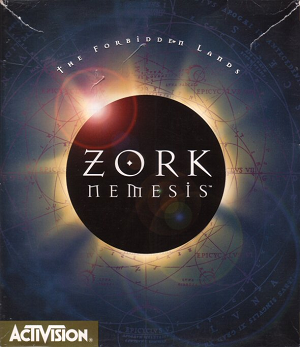
Zork Nemesis: The Forbidden Lands is a graphic adventure game developed by Zombie LLC, published by Activision, and released in 1996 for Windows 95, MS-DOS, and Macintosh. It is the eleventh game in the Zork series, and the first title not to be marketed under the Infocom label, while featuring a darker, less comical story within the Zork setting. The story focuses on players investigating the sudden disappearance of four prominent figures and their children to the hands of a mysterious being known as the "Nemesis", and uncovering a sinister plot during their investigations that they must thwart. The game features performances by Lauren Koslow, W. Morgan Sheppard, Allan Kolman, Stephen Macht, Paul Anthony Stewart, Merle Kennedy, and Bruce Nozick.

Beyond Zork is an interactive fiction computer game written by Brian Moriarty and released by Infocom in 1987. It was one of the last games in the Zork series developed by Infocom. It signified a notable departure from the standard format of Infocom's earlier games which relied purely on text and puzzle-solving: among other features, Beyond Zork incorporated a crude on-screen map, the use of character statistics and levels, and RPG combat elements.
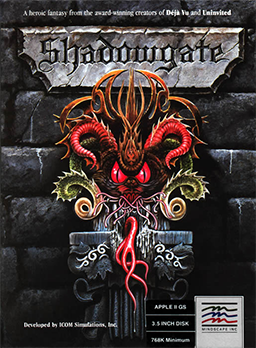
Shadowgate is a black-and-white point-and-click adventure game published for the Macintosh as part of the MacVenture series. The game is named for its setting, Castle Shadowgate, residence of the evil Warlock Lord. The player, as the "last of a great line of hero-kings" is charged with the task of saving the world by defeating the Warlock Lord, who is attempting to summon up the demon Behemoth out of Hell. Later that year, a color version of the game was released for the Amiga and Atari ST, and in 1989 for the Nintendo Entertainment System.

Vampire Hunter D is a PlayStation video game based on the series of books and movies of the same name. Along with Countdown Vampires, it is one of the few survival horror games to revolve around vampires.
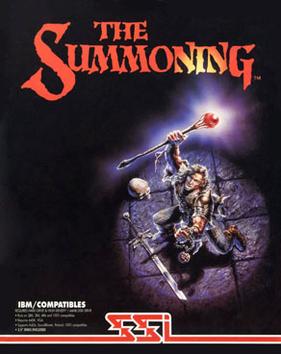
The Summoning is an isometric-view fantasy role-playing video game developed by Event Horizon Software and published by Strategic Simulations in 1992.
An action role-playing game is a subgenre of video games that combines core elements from both the action game and role-playing genre.

Buffy the Vampire Slayer: Chaos Bleeds is an action beat 'em up video game and the fourth of the Buffy the Vampire Slayer franchise, and the only multiplatform game. It was the first to allow players to control characters other than Buffy Summers and feature a fully developed multiplayer mode.

Buffy the Vampire Slayer: Wrath of the Darkhul King is a 2003 action platformer developed by Natsume and published by THQ for the Game Boy Advance. It was the third of six video games based on the television show Buffy the Vampire Slayer. The game follows Buffy Summers who fights vampires, demons, and other supernatural entities as the Slayer. Set in the show's fourth season, the story focuses on Buffy's attempt to prevent a demonic warlord from initiating an apocalypse event. The player controls Buffy through 16 side-scrolling levels that focus on solving puzzles and defeating enemies by using customizable weapons.

Gabriel Knight 3: Blood of the Sacred, Blood of the Damned is a point-and-click adventure game, developed and published by Sierra Studios for Microsoft Windows, and released in 1999. The sequel to 1995's The Beast Within: A Gabriel Knight Mystery and the third title in the Gabriel Knight series, the game's story focuses on the lives of Gabriel Knight, an author who is descended from a family that combats supernatural evils, and Grace Nakimura, a student who assists Gabriel, as they become engaged in a case that involves tracking down a kidnapped infant by vampires that is connected to the Holy Grail and Jesus. The setting is based on a real-life conspiracy theory about a hidden treasure, and involves elements of history and myths surrounding the Grail, vampires, and the Knights Templar.

Legacy of the Wizard, originally released in Japan as Dragon Slayer IV: Drasle Family, is a fantasy-themed action role-playing platform game released for the MSX, MSX2 and Famicom in Japan and for the Nintendo Entertainment System in the United States. Legacy of the Wizard is an installment in Falcom's Dragon Slayer series, and one of only five Dragon Slayer games that were localized outside Japan. The game was an early example of an open-world, non-linear action RPG, combining action-RPG gameplay with what would later be called "Metroidvania"-style action-adventure elements.
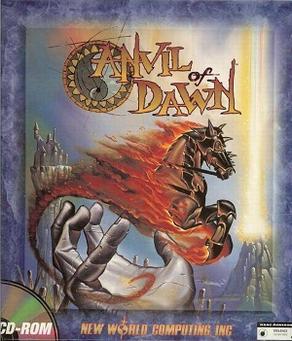
Anvil of Dawn is a 1995 fantasy role-playing video game developed by DreamForge Intertainment and published by New World Computing. Anvil of Dawn was named the best role-playing game of 1995 by Computer Gaming World and Computer Game Review.
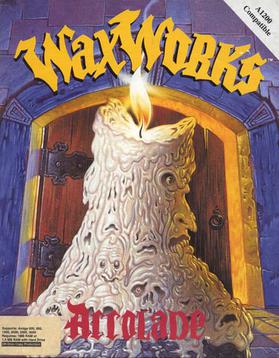
Waxworks is a horror-themed, first person dungeon crawl video game developed by Horror Soft and released in 1992. for Amiga, Macintosh, and DOS. The DOS release retains the Amiga 32-color palette rather than 256-color VGA graphics. This was the last game made by Horror Soft before they became Adventure Soft, the company known for the Simon the Sorcerer series. Waxworks was inspired by the 1988 film Waxwork.

The Buffy the Vampire Slayer Collectible Card Game is an out-of-print trading card game based on Buffy the Vampire Slayer. It was released in December 2001 by Score Entertainment. As of January 2004, Score Entertainment no longer holds the rights to this game. Hence, no further production runs or expansions for the game are planned.

Dracula 3: The Path of the Dragon is a 2008 point-and-click adventure video game developed by Kheops Studio for Microsoft Windows, and published by MC2 France under their Microïds label in Europe and Encore in North America. In 2010, an abridged version of the game developed by Tetraedge Games and published by Chillingo was released in a three-part episodic form for iOS. The full version of the game was ported to OS X in 2010, published by Coladia. Also in 2010, the three-part iOS version was made available for PC as the Dracula Series. In 2014, the abridged iOS version was made available as a single game on Steam.
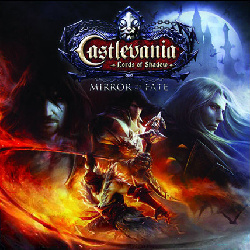
Castlevania: Lords of Shadow – Mirror of Fate is a Nintendo 3DS game in the Castlevania series. It was released in March 2013, and is a direct sequel to Castlevania: Lords of Shadow, which served as a reboot of the franchise.

The Legend of Kyrandia: Book One is a 2D point-and-click adventure game, and the first game in the Fables & Fiends series. It was developed by Westwood Studios and published by Virgin Games in August 1992.

















